 Paducah Site worker Brandon Hayden signals a crane operator to lower a motor from the C-333 Process Building’s cell floor to the truck alley for removal. The work was done to support the future construction of a material sizing area in the building, which will be used to downsize large components for disposal.
PADUCAH, Ky. – Since the inception of the EM program in 1989, the Paducah Site has made notable achievements in groundwater cleanup, waste removal, and other work advancing its environmental cleanup mission following more than 60 years of uranium enrichment operations and support activities.
Since 1989, the site has treated 4.6 billion gallons of groundwater, removed over 8,000 gallons of trichloroethylene from groundwater and soils, disposed 7.8 million cubic feet of waste, removed 66 million pounds of scrap metal from storage yards, and converted over 52,500 metric tons of depleted uranium hexafluoride into a more stable form for potential reuse or disposal.
Enrichment operations at Paducah ceased in 2013, paving the way for EM to expand cleanup and deactivation activities. Recent progress includes the removal of approximately 2 million pounds of an ozone-depleting refrigerant used in the site’s four process buildings.
EM also recently deactivated the C-400 Cleaning Building, an important step towards reaching an agreement with environmental regulators on the final actions required for addressing contamination within the city block surrounding the building.
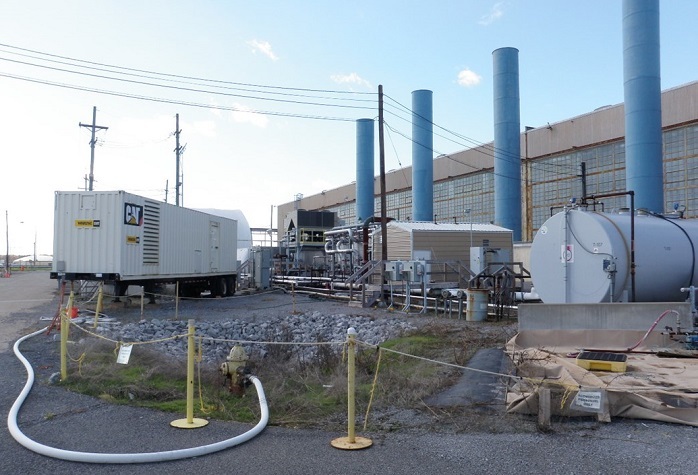 Pictured here are the equipment, tanks, and other items on the east side of the C-400 Cleaning Building at the Paducah Site. These items were removed, in part, to prepare for a remedial investigation that will allow EM to evaluate the source of off-site groundwater contamination located under the building.
 Paducah Site workers conduct drilling and groundwater sampling activities inside the C-400 Cleaning Building after the facility was deactivated. Since November 2019, EM has conducted field work as part of an ongoing groundwater investigation at the C-400 Complex, which includes the building and surrounding areas.
“So much has changed since the plant’s operations ceased nearly a decade ago,” said Jennifer Woodard, EM’s Portsmouth/Paducah Project Office Paducah site lead. “Our strategic approach had to evolve to incorporate cleanup scope resulting from the return of the leased uranium enrichment facilities, recognize and adjust the utility and infrastructure needs for the entire site, and understand the surveillance and maintenance cost impacts related to the returned facilities.”
Workers are also taking steps to deactivate the C-333 Process Building, a facility that is more than 80 feet high and covers about 25 acres on each floor, larger than 20 football fields. Steps taken include removing hazardous materials and equipment.
“Over the next several years, we have plans in place to make substantial progress at the C-400 Complex city block and the deactivation of the C-333 Process Building, which will bring us closer to achieving our long-term cleanup goals,” Woodard said.
 A view of the locations of major EM cleanup accomplishments at the Paducah Site since the inception of the cleanup program in 1989.
When operational, the site required infrastructure similar to that of a small city, with its own water treatment plant, fire department, security force, post office, medical facility, and sewage treatment plant. Since the plant ceased uranium enrichment, the needs at the site have changed.
Paducah previously maintained four electrical switchyards, supporting up to 3,000 megawatts of power per hour. This is enough energy to power a city as large as Nashville. Currently, the site’s cleanup mission only uses about 12 megawatts per hour.
The reduced need for electricity prompted the construction of a new electrical substation and power distribution system, operated by the Tennessee Valley Authority. The substation now carries the power load for the entire site. This change will result in significant cost and energy savings in the coming years.
 Earlier this year, EM took Paducah’s last remaining switchyard offline and transferred electrical loads to the new Tennessee Valley Authority substation. Paducah Site worker Cayce King connects a hose to a rail car to drain the oil from the C-531 Switchyard, the last switchyard to be deactivated at the site.
Water usage at the site has also changed since a majority of the site’s water was used as a coolant for the uranium enrichment process. Today, the site requires approximately 1.7 to 2.5 million gallons per day. When the plant was supporting the nation’s power needs, water usage could reach as high as 30 million gallons per day. Steps to replace two raw water pumps with ones that will operate using about 50% less power, resulting in additional energy cost savings, is currently underway.
“It will take many years before we complete our ultimate mission in Paducah,” Woodard said. “The Department is taking a systematic approach to position the site to have the correct infrastructure while continuing the environmental cleanup and deactivation activities.”
Deactivation and environmental remediation work continues to be a priority for leaders at the site. The advancements made in cleanup there lay the groundwork for future economic development in the region.
-Contributor: Dylan Nichols
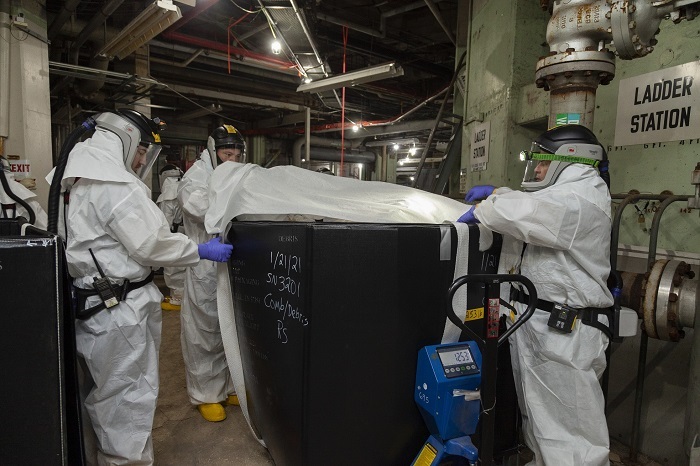 Workers remove waste from Alpha-2 as part of deactivation work at the Y-12 National Security Complex at Oak Ridge.
OAK RIDGE, Tenn. – EM is preparing the next wave of buildings for demolition at the Y-12 National Security Complex as part of a new chapter of cleanup in Oak Ridge.
Crews are deactivating three contaminated facilities at Y-12 after transitioning them to a “cold and dark” status in which all potential hazardous energy sources are isolated — a crucial step before full-scale deactivation.
Workers are addressing vacant 1940s-era buildings that do not support current-day Y-12 missions. EM and its contractor UCOR are focusing their efforts on Alpha-2, the Old Steam Plant, and the Old Criticality Experiment Laboratory. The latter is the only building of the three that was not built as part of the Manhattan Project.
UCOR is working simultaneously in all three buildings. Some team members isolated utilities and equipment while others performed early deactivation tasks such as abating asbestos and removing waste. Oak Ridge’s highly experienced workforce has made it possible to conduct all of this work in tandem.
“These crews were part of the team that completed the first-in-the-world removal of a gaseous diffusion complex last year, and they also completed demolition prep for the Biology Complex at Y-12,” UCOR Oak Ridge Reservation Environmental Cleanup Manager Dan Macias said. “The skills and training these workers bring to each project allow them to successfully complete our work safely and efficiently.”
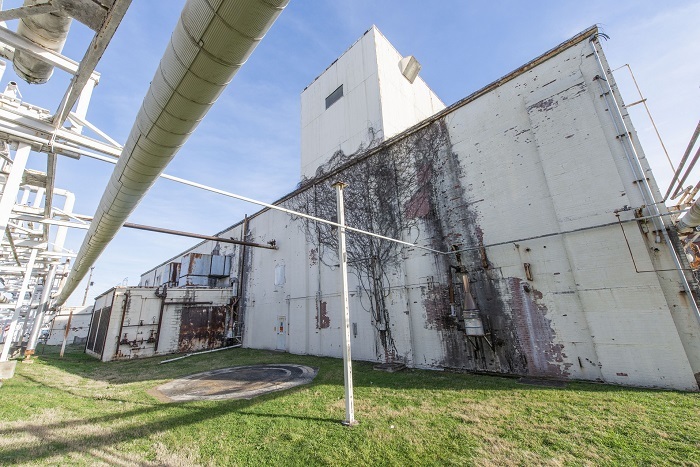 The Old Steam Plant at the Y-12 National Security Complex dates back to 1943. It has had multiple uses over the years, but today it is in a deteriorated state and does not support any current missions.
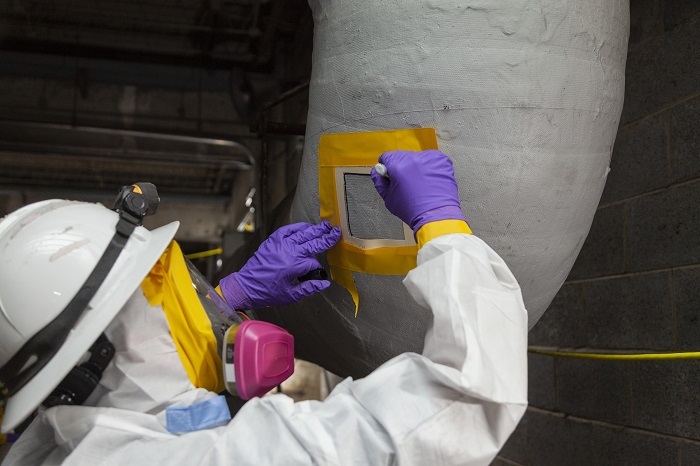 A worker takes samples inside Alpha-2 at Y-12 National Security Complex to characterize any risks and hazards in the building for EM to safely plan and perform deactivation efforts.
An exterior view of the Old Criticality Experiment Laboratory at the Y-12 National Security Complex. It was built in 1949 and was home to more than 9,700 experiments from 1950 until 1961. The building has been closed since 1992.
More than 50% of the facilities throughout the National Nuclear Security Administration complex, which includes Y-12, are more than 40 years old, and 30% of them were built in the Manhattan Project age. EM’s work in Oak Ridge is beginning to remove this deteriorating infrastructure to enable modernization and provide land for national security missions.
Alpha-2, also known as Building 9201-2, is the largest building where deactivation is underway at the site. The three-story, 325,000-square-foot facility was constructed to enrich uranium using an electromagnetic separation process, which ended in 1946. The facility was used for a variety of other missions until it was shut down in the 1990s.
The Old Steam Plant, also known as Building 9401-1, is a single-story, 13,454-square-foot facility built in 1943. This building has had multiple uses over the years. In the 1960s and 1970s, it was used to develop a dipping process for uranium parts. Subsequently, the Oak Ridge National Laboratory (ORNL) used the facility to test fuels, and it later became a maintenance and storage facility.
The Old Criticality Experiment Laboratory, also known as Building 9213, was built in 1949. The two-story, 24,000-square-foot facility was home to more than 9,700 experiments from 1950 until 1961. It was later used to support ORNL’s High-Flux Isotope Reactor program. The building has been closed since 1992.
The massive cleanup at Y-12 is happening simultaneously with other cleanup projects underway at ORNL, where crews are addressing 16 inactive research reactor and isotope facilities.
-Contributor: Susanne Dupes
 Travis Radomski, Gregory Jacobs, and Tage Soderlund are West Valley Demonstration Project (WVDP) security police officers (SPO) who recently completed basic security police officer training. They are pictured with their instructors at their graduation ceremony. From left are SPO Jason Chatterson, WVDP Protective Force Sgt. Ryan Miller, WVDP Protective Force Sgt. Timothy Blovsky, Radomski, Jacobs, Soderlund, Cattaraugus County Sheriff’s Office (CCSO) Sgt. Jason Dry, WVDP Protective Force Sgt James Madsen, and CCSO Investigator Ken Rice.
WEST VALLEY, N.Y. – The West Valley Demonstration Project (WVDP) recently conducted a graduation ceremony for three security police officers who completed a seven-week security training course through a first-time partnership with the local sheriff’s office.
The officers, Travis Radomski, Gregory Jacobs, and Tage Soderlund, would normally take the course at DOE’s National Training Center (NTC) in Albuquerque, New Mexico. However, there was no space available for them at the center’s basic security police officer training course this year due to a large number of new recruits from across the DOE complex requiring training.
As a result, the WVDP management team — which consists of representatives from EM, its cleanup contractor CH2M HILL BWXT West Valley (CHBWV), and security subcontractor Paragon Energy — developed a plan for the officers to be trained by instructors from Paragon and the Cattaraugus County Sheriff’s Office using facilities of the sheriff’s office. The training plan was approved by the NTC.
“We understand the importance and benefit of having trained emergency responders working at West Valley,” EM WVDP Director Bryan Bower said. “As trained and qualified officers, they now have increased responsibilities to protect the health and safety of our workers and the public. We appreciate their continued commitment and dedication to integrity, vigilance, and helpfulness.”
The three officers who completed the course had previously worked as unarmed security officers at WVDP. The course included firearm qualifications, defensive tactics, use of force, first aid and combat casualty care, improvised explosive device and bomb training, vehicle stops, DOE tactical doctrine, physical fitness, and other required courses of study.
“Partnering with the WVDP on their security police officer training was an easy decision to make,” Cattaraugus County Sheriff Timothy Whitcomb said. “We have partnered with them before and welcome future opportunities to work together to protect the site, workers, and the public.”
The sheriff’s office training coordinator, bomb squad technician, and special response team helped conduct the training.
"We recognize and celebrate this continued partnership and its successes,” EM WVDP Acting Security Manager Anthony Lechanski said. “Over the past couple weeks, our leaders trained, developed, and mentored these employees and showed that this team has what it takes at all levels. It is because of the dedicated efforts of this small group of individuals that I humbly say, ‘Thank you,’ and look forward to what will be accomplished in the future.”
Dave Schuman, CHBWV safeguards and security manager, said it was important for the WVDP management team to recognize the graduates for completing the training, and to show their families gratitude for their efforts.
“This training pushed these recruits both mentally and physically, and we applaud them for their commitment and perseverance,” Schuman said.
-Contributor: Joseph Pillittere
 Crews with Savannah River Remediation recently completed modifications to convert Tank 42 into the third blend tank for Salt Waste Processing Facility feed. Pictured is the site of Tank 42.
AIKEN, S.C. – A third tank at the Savannah River Site (SRS) has been converted into a blend tank to support feeding waste to the Salt Waste Processing Facility (SWPF).
With completion of Tank 42 modifications, EM now has three tanks —21, 41, and 42 — in the site’s H Tank Farm that will serve as blend tanks for SWPF. The blend tanks provide space for preparing salt waste batches to be transferred to SWPF. Each tank can hold 1 million gallons and will prepare up to 3 million gallons of salt waste feed each year for processing at SWPF.
EM’s liquid waste contractor, Savannah River Remediation (SRR), manages and operates the SRS tank farms and provides the salt batches to be transferred to SWPF, which are planned to reach a rate of 9 million gallons each year in the future. EM contractor Parsons designed and constructed SWPF and has operated the facility since it began processing radioactive salt waste in October 2020.
Prior to SWPF operations, one blend tank was required for processing through the previous interim salt processing facilities, Actinide Removal Process (ARP) and Modular Caustic Side Solvent Extraction Unit (ARP/MCU). On a smaller scale, ARP/MCU, operated by SRR, proved the technologies for removing the radioactive components of salt waste implemented in SWPF. The interim facilities processed 7.4 million gallons of salt waste. ARP/MCU operations were suspended in 2019 to prepare final SWPF tie-ins with the liquid waste facilities.
SRR completed a series of complex projects over many years to complete the tank modifications. Once a waste tank is ready to serve as an SWPF blend tank, liquid salt waste from other waste tanks is combined to meet the specific waste acceptance criteria for SWPF.
DOE-Savannah River Assistant Manager for Waste Disposition Jim Folk said the liquid waste program at SRS is aligned to meet EM’s Strategic Vision 2021-2031, and SRS is well positioned to support that vision.
“The work to prepare salt waste batches for processing at the Salt Waste Processing Facility includes changing how our tanks are used and how to best position SRS for success in this area,” Folk said. “With the progress that has already occurred, the liquid waste mission at SRS continues to demonstrate that the safety of the community and environment remain a top priority.”
The SRR team overcame many challenges over the last several years to complete the blend tank modifications project, according to SRR Chief Operating Officer and Deputy Project Manager Mark Schmitz.
“Savannah River Remediation has the critical responsibility to prepare salt feed for the Salt Waste Processing Facility, and the team has already achieved four salt batches — four million gallons of feed,” Schmitz said. “Utilization of three blend tanks now enables SRR to achieve even higher rates of salt feed preparation.”
-Contributors: Ashley Dernberger, Colleen Hart
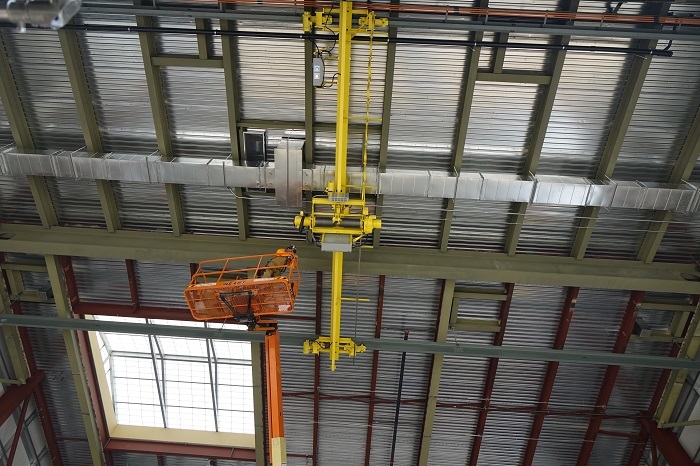 Pictured on a lift, Rick O’Hair, a rigger with crane consultant Paul Parish Ltd., monitors a ceiling-mounted crane at the Low-Activity Waste Melter Assembly, Storage and Transportation facility near the Hanford Site during recent load testing.
RICHLAND, Wash. – EM Office of River Protection (ORP) contractor Washington River Protection Solutions (WRPS) recently conducted load testing on a crane that will play a crucial role in assembling spare melters critical to tank waste treatment at the Hanford Site.
“Once the Waste Treatment and Immobilization Plant begins operations, the facility will use two melters operating around the clock,” said ORP’s Joe Renevitz, who oversees future operations of the plant. “It’s imperative we have the two replacement melters available to minimize processing impacts.”
The melters are the heart of Hanford’s Direct-Feed Low-Activity Waste Program, which will deliver treated waste from the tank farms directly to the plant for vitrification, or immobilization in glass form, for safe disposal. The tank waste will be mixed in the melters with glass-forming materials at 2,100 degrees Fahrenheit.
The melters have an expected lifespan of five years. Since replacement melters take a few years to build, WRPS is already preparing to assemble the spares.
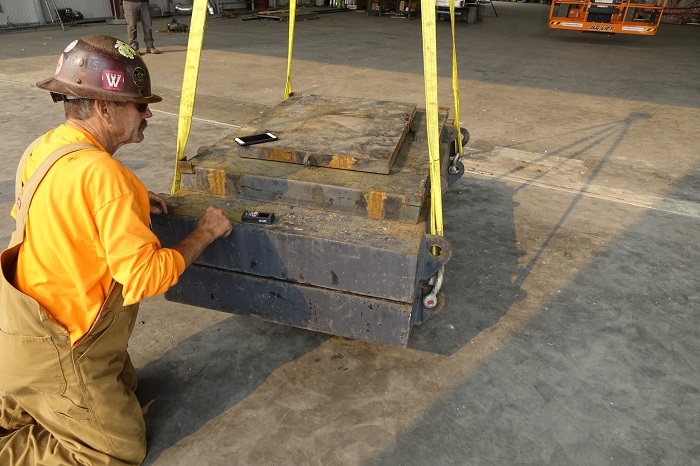 Rick O’Hair, a rigger with crane consultant Paul Parish Ltd., checks a device that measures the distance a crane has carried a test load to ensure the crane is working properly and can handle the loads needed to complete the assembly of replacement melters for the Waste Treatment and Immobilization Plant at the Hanford Site.
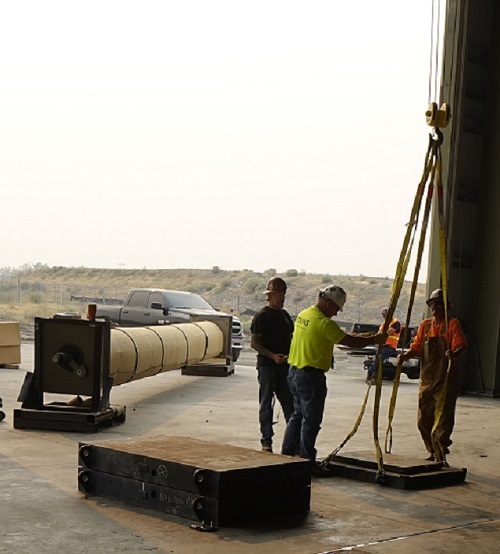 |
|
Crews at the Low-Activity Waste Melter Assembly, Storage and Transportation facility near the Hanford Site begin testing the load capacity of a 5-ton crane that will be used to assemble replacement melters for the Waste Treatment and Immobilization Plant. |
The Low-Activity Waste Melter Assembly, Storage and Transportation (LAWMAST) facility near the Hanford Site is where the replacements will be assembled and stored. The LAWMAST building was once used for full-scale vessel testing in support of the treatment plant and is being repurposed for the melter assembly.
To help with the assembly process, workers installed a 5-ton crane. As a requirement of testing, the crane needed to have the ability to lift 25% more than the expected capacity. The crane met that requirement, lifting 12,500 pounds.
“Some melter components, including the lid, are too heavy for this crane to lift, so we’ll bring in a mobile crane for these infrequent operations,” said Allan Exley, manager of operations planning integration. “The 5-ton crane will be used for routine melter assembly activities like filling the melter with large ceramic blocks that each weight about a ton.”
There are a few more construction items to finish before crews can begin installing additional components necessary for assembling the melters. Assembly is expected to begin once the melter shells are delivered to the LAWMAST facility in summer 2022.
-Contributor: Jenna Kochenauer
|